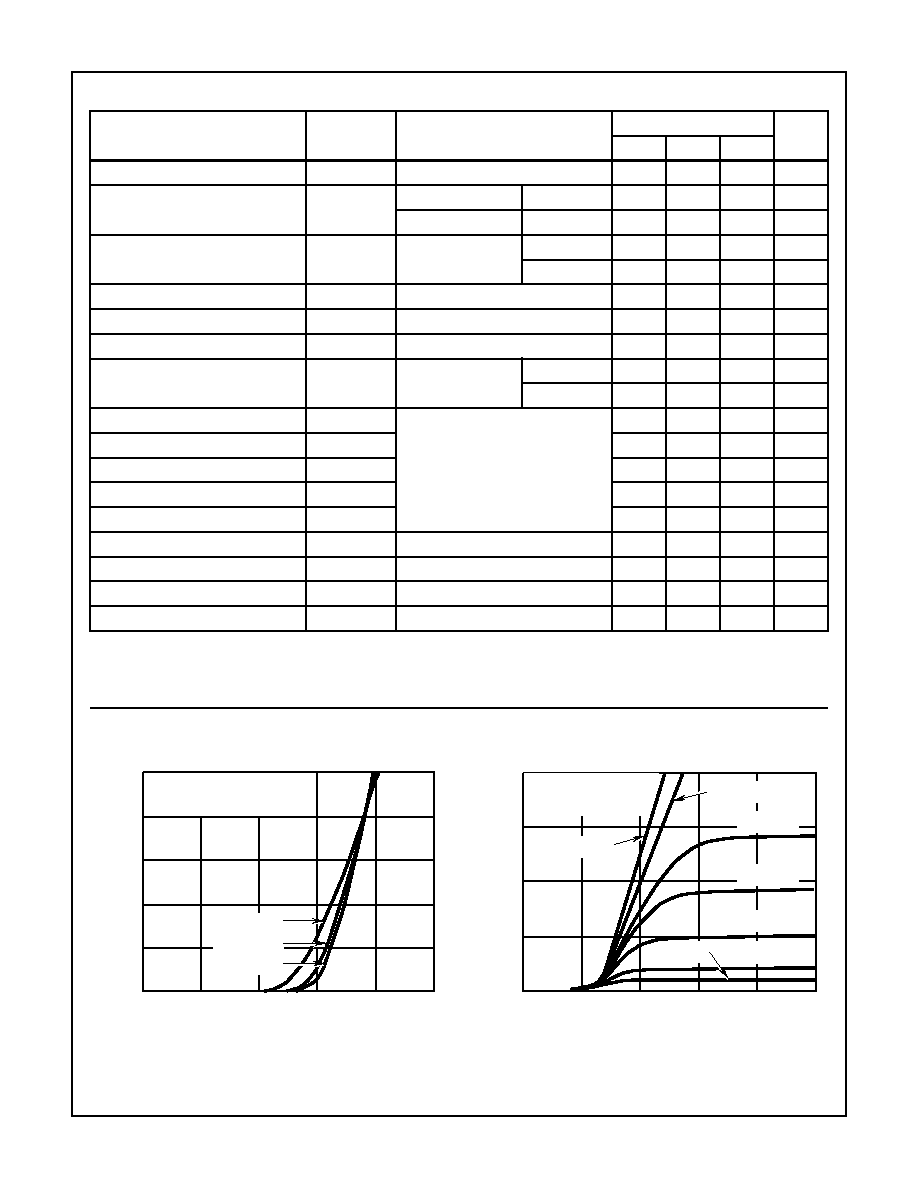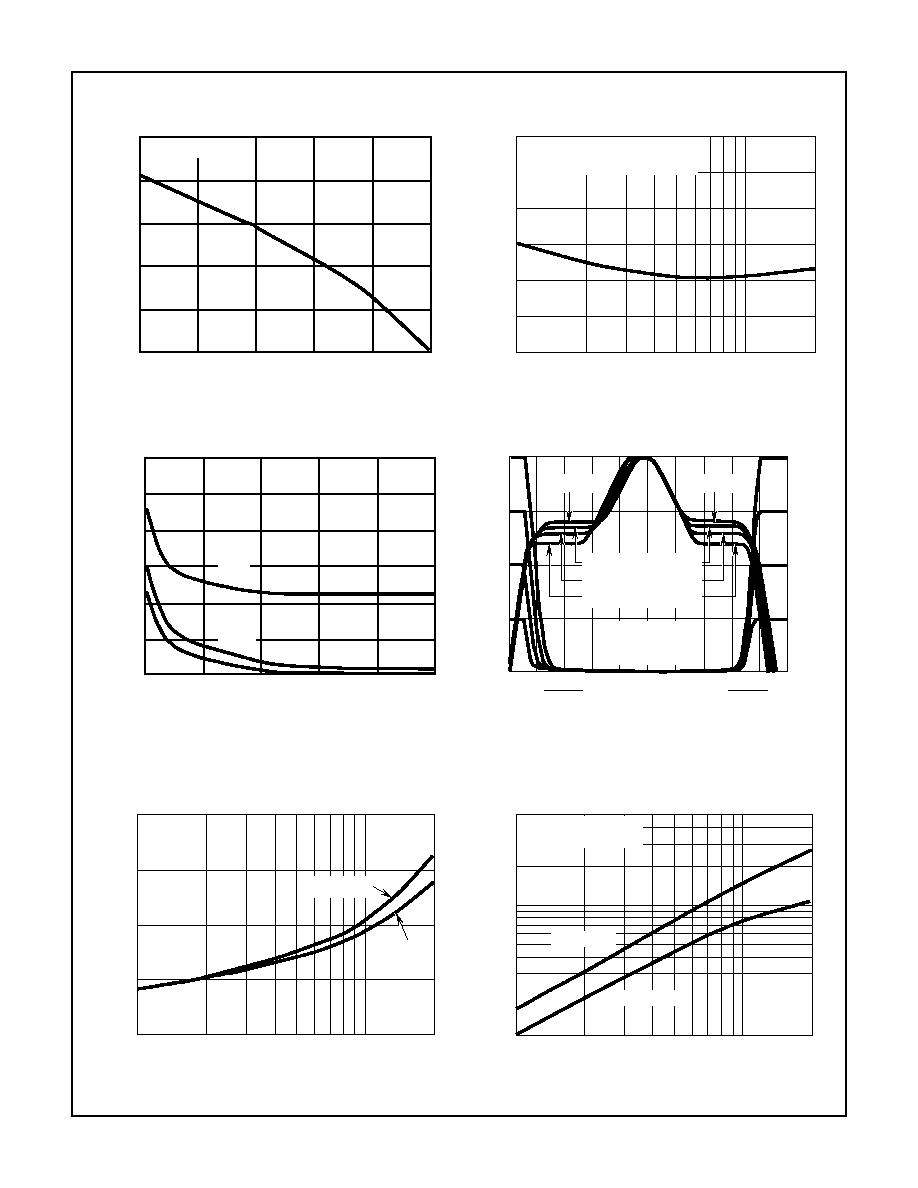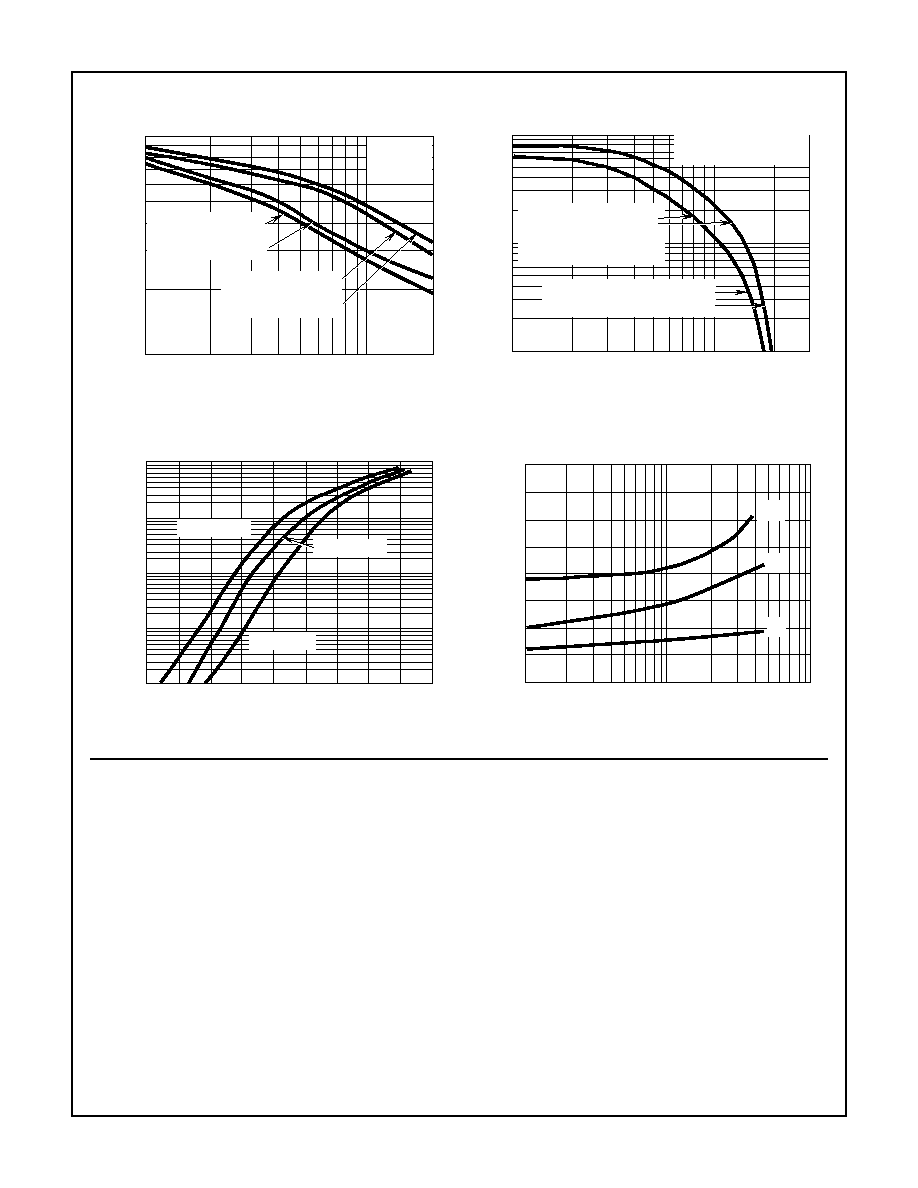
3-46
CAUTION: These devices are sensitive to electrostatic discharge; follow proper IC Handling Procedures.
http://www.intersil.com or 407-727-9207
|
Copyright
©
Intersil Corporation 1999
Features
· 12A, 600V
· Latch Free Operation
· Typical Fall Time <500ns
· Low Conduction Loss
· With Anti-Parallel Diode
· t
RR
< 60ns
Description
The IGBT is a MOS gated high voltage switching device
combining the best features of MOSFETs and bipolar
transistors. The device has the high input impedance of a
MOSFET and the low on-state conduction loss of a bipolar
transistor. The much lower on-state voltage drop varies only
moderately between +25
o
C and +150
o
C. The diode used in
parallel with the IGBT is an ultrafast (t
RR
< 60ns) with soft
recovery characteristic.
The IGBTs are ideal for many high voltage switching applica-
tions operating at frequencies where low conduction losses
are essential, such as: AC and DC motor controls, power
supplies and drivers for solenoids, relays and contactors.
PACKAGING AVAILABILITY
PART NUMBER
PACKAGE
BRAND
HGTG12N60D1D
TO-220AB
G12N60D1D
NOTE: When ordering, use the entire part number
April 1995
HGTG12N60D1D
12A, 600V N-Channel IGBT
with Anti-Parallel Ultrafast Diode
Package
JEDEC STYLE TO-247
Terminal Diagram
N-CHANNEL ENHANCEMENT MODE
COLLECTOR
GATE
COLLECTOR
EMITTER
(BOTTOM SIDE
METAL)
C
G
E
Absolute Maximum Ratings
T
C
= +25
o
C, Unless Otherwise Specified
HGTG12N60D1D
UNITS
Collector-Emitter Voltage . . . . . . . . . . . . . . . . . . . . . . . . . . . . . . . . . . . . . . . . . . . . . . . . BV
CES
600
V
Collector-Gate Voltage R
GE
= 1M
. . . . . . . . . . . . . . . . . . . . . . . . . . . . . . . . . . . . . . . . BV
CGR
600
V
Collector Current Continuous at T
C
= +25
o
C . . . . . . . . . . . . . . . . . . . . . . . . . . . . . . . . . . . .I
C25
21
A
at T
C
= +90
o
C . . . . . . . . . . . . . . . . . . . . . . . . . . . . . . . . . . . .I
C90
12
A
Collector Current Pulsed (Note 1) . . . . . . . . . . . . . . . . . . . . . . . . . . . . . . . . . . . . . . . . . . . . I
CM
48
A
Gate-Emitter Voltage Continuous. . . . . . . . . . . . . . . . . . . . . . . . . . . . . . . . . . . . . . . . . . . V
GES
±
20
V
Switching Safe Operating Area at T
J
= +150
o
C . . . . . . . . . . . . . . . . . . . . . . . . . . . . . . . . SSOA
30A at 0.8 BV
CES
-
Diode Forward Current at T
C
= +25
o
C . . . . . . . . . . . . . . . . . . . . . . . . . . . . . . . . . . . . . . . . . I
F25
21
A
at T
C
= +90
o
C . . . . . . . . . . . . . . . . . . . . . . . . . . . . . . . . . . . . . . . . . I
F90
12
A
Power Dissipation Total at T
C
= +25
o
C . . . . . . . . . . . . . . . . . . . . . . . . . . . . . . . . . . . . . . . . P
D
75
W
Power Dissipation Derating T
C
> +25
o
C . . . . . . . . . . . . . . . . . . . . . . . . . . . . . . . . . . . . . . . . . .
0.6
W/
o
C
Operating and Storage Junction Temperature Range . . . . . . . . . . . . . . . . . . . . . . . . . T
J
, T
STG
-55 to +150
o
C
Maximum Lead Temperature for Soldering . . . . . . . . . . . . . . . . . . . . . . . . . . . . . . . . . . . . . . T
L
260
o
C
(0.125 inches from case for 5s)
NOTE:
1. Repetitive Rating: Pulse width limited by maximum junction temperature.
INTERSIL CORPORATION IGBT PRODUCT IS COVERED BY ONE OR MORE OF THE FOLLOWING U.S. PATENTS:
4,364,073
4,417,385
4,430,792
4,443,931
4,466,176
4,516,143
4,532,534
4,567,641
4,587,713
4,598,461
4,605,948
4,618,872
4,620,211
4,631,564
4,639,754
4,639,762
4,641,162
4,644,637
4,682,195
4,684,413
4,694,313
4,717,679
4,743,952
4,783,690
4,794,432
4,801,986
4,803,533
4,809,045
4,809,047
4,810,665
4,823,176
4,837,606
4,860,080
4,883,767
4,888,627
4,890,143
4,901,127
4,904,609
4,933,740
4,963,951
4,969,027
File Number
2800.4

3-47
Specifications HGTG12N60D1D
Electrical Specifications
T
C
= +25
o
C, Unless Otherwise Specified
PARAMETERS
SYMBOL
TEST CONDITIONS
LIMITS
UNITS
MIN
TYP
MAX
Collector-Emitter Breakdown Voltage
BV
CES
I
C
= 280
µ
A, V
GE
= 0V
600
-
-
V
Collector-Emitter Leakage Voltage
I
CES
V
CE
= BV
CES
T
C
= +25
o
C
-
-
280
µ
A
V
CE
= 0.8 BV
CES
T
C
= +125
o
C
-
-
5.0
mA
Collector-Emitter Saturation Voltage
V
CE(SAT)
I
C
= I
C90
, V
GE
= 15V
T
C
= +25
o
C
-
1.9
2.5
V
T
C
= +125
o
C
-
2.1
2.7
V
Gate-Emitter Threshold Voltage
V
GE(TH)
I
C
= 250
µ
A, V
CE
= V
GE
, T
C
= +25
o
C
3.0
4.5
6.0
V
Gate-Emitter Leakage Current
I
GES
V
GE
=
±
20V
-
-
±
500
nA
Gate-Emitter Plateau Voltage
V
GEP
I
C
= I
C90
, V
CE
= 0.5 BV
CES
-
7.2
-
V
On-State Gate Charge
Q
G(ON)
I
C
= I
C90
,
V
CE
= 0.5 BV
CES
V
GE
= 15V
-
45
60
nC
V
GE
= 20V
-
70
90
nC
Current Turn-On Delay Time
t
D(ON)I
L = 500
µ
H, I
C
= I
C90
, R
G
= 25V,
V
GE
= 15V, T
J
= +150
o
C,
V
CE
= 0.8 BV
CES
-
100
-
ns
Current Rise Time
t
RI
-
150
-
ns
Current Turn-Off
t
D(OFF)I
-
430
600
ns
Current Fall Time
t
FI
-
430
600
ns
Turn-Off Energy (Note 1)
W
OFF
-
1.8
-
mJ
Thermal Resistance IGBT
R
JC
-
-
1.67
o
C/W
Thermal Resistance Diode
R
JC
-
-
1.5
o
C/W
Diode Forward Voltage
V
EC
I
EC
= 12A
-
-
1.50
V
Diode Reverse Recovery Time
t
RR
I
EC
= 12A, dI
EC
/dt = 100A/
µ
s
-
-
60
ns
NOTE:
1. Turn-off Energy Loss (W
OFF
) is defined as the integral of the instantaneous power loss starting at the trailing edge of the input pulse and
ending at the point where the collector current equals zero (I
CE
= 0A). The HGTG12N60D1D was tested per JEDEC standard No. 24-1
Method for Measurement of Power Device Turn-off Switching Loss. This test method produces the true total Turn-off Energy Loss.
Typical Performance Curves
FIGURE 1. TRANSFER CHARACTERISTICS (TYPICAL)
FIGURE 2. SATURATION CHARACTERISTICS (TYPICAL)
20
16
12
8
4
0
I
CE
, COLLECT
OR-EMITTER CURRENT (A)
0
2
4
6
8
10
V
GE
, GATE-EMITTER VOLTAGE (V)
T
C
= +150
o
C
T
C
= +25
o
C
T
C
= -40
o
C
PULSE DURATION = 250
µ
s
DUTY CYCLE < 0.5%
V
CE
= 10V
20
15
10
5
0
0
1
2
3
4
5
V
CE
, COLLECTOR-EMITTER VOLTAGE (V)
PULSE DURATION = 250
µ
s
DUTY CYCLE < 0.5%
T
C
= +25
o
C
V
GE
= 15V
V
GE
= 10V
V
GE
= 7.5V
V
GE
= 7.0V
V
GE
= 6.5V
V
GE
= 6.0V
V
GE
= 5.7V
I
CE
, COLLECT
OR-EMITTER CURRENT (A)

3-48
HGTG12N60D1D
FIGURE 3. DC COLLECTOR CURRENT vs CASE TEMPERATURE
FIGURE 4. FALL TIME vs COLLECTOR-EMITTER CURRENT
FIGURE 5. CAPACITANCE vs COLLECTOR-EMITTER VOLTAGE
FIGURE 6. NORMALIZED SWITCHING WAVEFORMS AT CON-
STANT GATE CURRENT. (REFER TO APPLICATION
NOTES AN7254 AND AN7260)
FIGURE 7. SATURATION VOLTAGE vs COLLECTOR-EMITTER
CURRENT
FIGURE 8. TURN-OFF SWITCHING LOSS vs COLLECTOR-
EMITTER CURRENT
Typical Performance Curves
(Continued)
25
20
15
10
5
0
I
CE
, COLLECT
OR CURRENT (A)
+25
+50
+75
+100
+125
+150
T
C
, CASE TEMPERATURE (
o
C)
V
GE
= 15V
1200
1000
800
600
400
200
0
t
FI
, F
ALL TIME (ns)
1
10
20
PEAK COLLECTOR-EMITTER CURRENT (A)
V
CE
= 480V, V
GE
= 10V AND 15V
T
J
= +150
o
C, R
GE
= 25
, L = 500
µ
H
3000
2500
2000
1500
1000
500
0
C, CAP
ACIT
ANCE (pF)
0
5
10
15
20
25
V
CE
, COLLECTOR-EMITTER VOLTAGE (V)
f = 1MHz
CISS
COSS
CRSS
600
450
300
150
0
V
CE
, COLLECT
OR-EMITTER VOL
T
AGE (V)
10
7.5
5.0
2.5
0
V
GE
, GA
TE-EMITTER VOL
T
AGE (V)
20
I
G(REF)
I
G(ACT)
80
I
G(REF)
I
G(ACT)
TIME (
µ
s)
0.75 BV
CES
0.50 BV
CES
0.25 BV
CES
0.75 BV
CES
0.50 BV
CES
0.25 BV
CES
V
CC
= BV
CES
V
CC
= BV
CES
R
L
= 60
I
G(REF)
= 0.868mA
V
GE
= 10V
4
3
2
1
0
V
CE(ON)
, SA
TURA
TION VOL
T
AGE (V)
1
10
20
I
CE
, COLLECTOR-EMITTER CURRENT (A)
T
J
= +150
o
C
V
GE
= 10V
V
GE
= 15V
5.0
1.0
0.1
1
20
10
I
CE
, COLLECTOR-EMITTER CURRENT (A)
T
J
= +150
o
C, V
GE
= 10V
R
GE
= 25
, L = 500
µ
H
V
CE
= 480V
V
CE
= 240V
W
OFF
, TURN-OFF SWITCHING LOSS (mJ)

3-49
HGTG12N60D1D
FIGURE 9. TURN-OFF DELAY vs COLLECTOR-EMITTER
CURRENT
FIGURE 10. OPERATING FREQUENCY vs COLLECTOR-
EMITTER CURRENT AND VOLTAGE
FIGURE 11. TYPICAL DIODE EMITTER-TO-COLLECTOR VOLTAGE
FIGURE 12. TYPICAL t
RR
, t
A
, t
B
vs FORWARD CURRENT
Typical Performance Curves
(Continued)
1000
100
1
10
20
I
CE
, COLLECTOR-EMITTER CURRENT (A)
V
CE
= 240V, V
GE
= 10V
V
CE
= 240V, V
GE
= 15V
V
CE
= 480V, V
GE
= 10V
V
CE
= 480V, V
GE
= 15V
T
J
= +150
o
C
R
GE
= 25
L = 500
µ
H
t
D(OFF)I
, TURN-OFF DELA
Y (ns)
100
10
1
f
OP
, OPERA
TING FREQUENCY (kHz)
1
10
30
I
CE
, COLLECTOR-EMITTER CURRENT (A)
T
J
= +150
o
C, T
C
= +100
o
C
R
G
= 25
, L = 500
µ
H
f
MAX1
= 0.05/t
D(OFF)I
f
MAX2
= (P
D
- P
C
)/W
OFF
P
C
= DUTY FACTOR = 50%
R
JC
= 1.67
o
C/W
V
CE
= 480V, V
GE
= 10V AND 15V
V
CE
= 480V, V
GE
= 10V AND 15V
P
D
= ALLOWABLE DISSIPATION
P
C
= CONDUCTION DISSIPATION
NOTE:
100
10
1.0
0.1
0.01
I
EC
, EMITTER-COLLECT
OR CURRENT (A)
0
0.2
0.4
0.6
0.8
1.0
1.2
1.4
1.6
1.8
V
EC
, EMITTER-COLLECTOR VOLTAGE (V)
T
J
= +150
o
C
T
J
= +100
o
C
T
J
= +25
o
C
80
70
60
50
40
30
20
10
0
t, RECOVER
Y TIMES (ns)
1
10
100
I
EC
, EMITTER-COLLECTOR CURRENT (A)
t
RR
t
A
t
B
Operating Frequency Information
Operating frequency information for a typical device (Figure
10) is presented as a guide for estimating device
performance for a specific application. Other typical
frequency vs collector current (I
CE
) plots are possible using
the information shown for a typical unit in Figures 7, 8 and 9.
The operating frequency plot (Figure 10) of a typical device
shows f
MAX1
or f
MAX2
whichever is smaller at each point. The
information is based on measurements of a typical device
and is bounded by the maximum rated junction temperature.
f
MAX1
is defined by f
MAX1
= 0.05/t
D(OFF)I
. t
D(OFF)I
deadtime
(the denominator) has been arbitrarily held to 10% of the on-
state time for a 50% duty factor. Other definitions are
possible. t
D(OFF)I
is defined as the time between the 90%
point of the trailing edge of the input pulse and the point
where the collector current falls to 90% of its maximum
value. Device turn-off delay can establish an additional
frequency limiting condition for an application other than
T
JMAX
. t
D(OFF)I
is important when controlling output ripple
under a lightly loaded condition.
f
MAX2
is defined by f
MAX2
= (P
D
- P
C
)/W
OFF
. The allowable
dissipation (P
D
) is defined by P
D
= (T
JMAX
- T
C
)/R
JC
. The
sum of device switching and conduction losses must not
exceed P
D
. A 50% duty factor was used (Figure 10) so that
the conduction losses (P
C
) can be approximated by P
C
=
(V
CE
x I
CE
)/2. W
OFF
is defined as the sum of the instanta-
neous power loss starting at the trailing edge of the input
pulse and ending at the point where the collector current
equals zero (I
CE
- 0A).
The switching power loss (Figure 10) is defined as f
MAX1
x
W
OFF
. Turn on switching losses are not included because
they can be greatly influenced by external circuit conditions
and components.

3-50
CAUTION: These devices are sensitive to electrostatic discharge; follow proper IC Handling Procedures.
http://www.intersil.com or 407-727-9207
|
Copyright
©
Intersil Corporation 1999
All Intersil semiconductor products are manufactured, assembled and tested under ISO9000 quality systems certification.
Intersil products are sold by description only. Intersil Corporation reserves the right to make changes in circuit design and/or specifications at any time without
notice. Accordingly, the reader is cautioned to verify that data sheets are current before placing orders. Information furnished by Intersil is believed to be accurate
and reliable. However, no responsibility is assumed by Intersil or its subsidiaries for its use; nor for any infringements of patents or other rights of third parties which
may result from its use. No license is granted by implication or otherwise under any patent or patent rights of Intersil or its subsidiaries.
For information regarding Intersil Corporation and its products, see web site http://www.intersil.com
Sales Office Headquarters
NORTH AMERICA
Intersil Corporation
P. O. Box 883, Mail Stop 53-204
Melbourne, FL 32902
TEL: (407) 724-7000
FAX: (407) 724-7240
EUROPE
Intersil SA
Mercure Center
100, Rue de la Fusee
1130 Brussels, Belgium
TEL: (32) 2.724.2111
FAX: (32) 2.724.22.05
ASIA
Intersil (Taiwan) Ltd.
Taiwan Limited
7F-6, No. 101 Fu Hsing North Road
Taipei, Taiwan
Republic of China
TEL: (886) 2 2716 9310
FAX: (886) 2 2715 3029
HGTG12N60D1D




